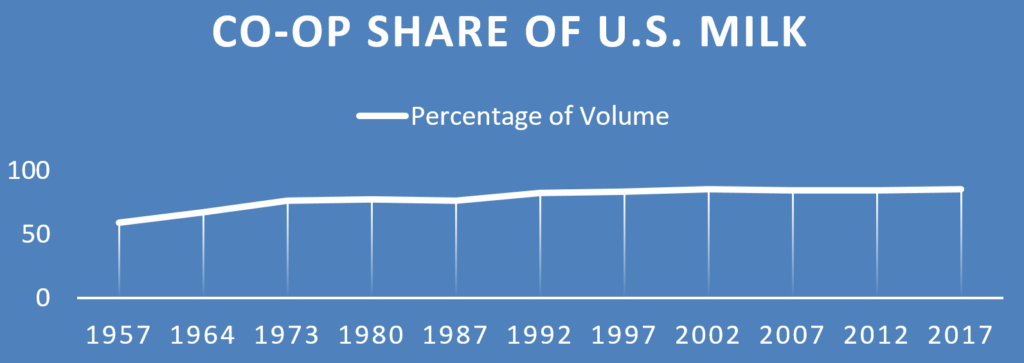Dairy Defined: Working Together is the Heart of Dairy
October 28, 2019
ARLINGTON, Va. – Dairy is a quirky commodity. It’s a highly perishable product “harvested” every day. It’s in all 50 states. And more than for most other commodities, dairy farmers are organized into cooperatives, putting the cooperative principle of working together at the heart of the industry.
Cooperatives are everywhere in the U.S., serving members in everything from child care and credit unions to health insurance and rural broadband. Nearly one in three Americans are co-op members. (And happy Co-op Month to all of them!) Thanks to the Capper-Volstead Act of 1922, farmers can form cooperatives to collectively own and manage resources, cut costs and gain a measure of market power traditionally dominated by banks and agribusiness.
Most U.S. farmers use cooperatives at some level – to pool supplies and capital, finance exports, improve their bargaining position with processors, or even become processors themselves. Over time, cooperatives became the dairy industry standard, as farmers far from cities needed ways to sell and ship highly perishable products without relying on middlemen who could use time and distance to push prices down. Cooperatives have empowered dairy farmers and enabled them to build multimillion-dollar processing plants in local communities, share financial resources, and coordinate their own transportation. It’s simply the best way, and sometimes the only way, for a dairy farmer to get products to market and earn a decent return from doing so. And while dairy co-ops don’t have the ability to set market prices – supply and demand still rules – they do help balance the market power equation between individual farmers and corporate buyers.
Today, farmer-owned cooperatives dominate dairy. According to a twice-a-decade USDA survey, cooperatives handled 85 percent of U.S. milk in 2017, a number that’s held steady for 25 years.
Thanks to cooperatives, dairy farmers have kept a bigger share of the price of their product – about twice the agricultural norm. And they’ve helped farmers benefit from marketplace shifts in ways they wouldn’t be able to if they only were solo operators selling their milk to others; for example, as dairy demand has reached a 56-year high, the number of cooperative-owned processing plants has risen by 8 percent since 2012. Another example: As butter prices have reached records, the share of butter production managed by cooperatives has risen to 86 percent, compared to 75 percent in 2012. Cooperatives have also helped dairy be a livestock-sector leader in sustainability and animal welfare, adapting generations of self-help spirit to 21st-century concerns.
Dairy cooperatives today include multi-billion-dollar businesses and local treasures; export powerhouses and instantly recognizable brands; innovative consumer products and food-cult followings. They’re part of regional fabrics, any they boast histories that stretch more than a century. Like agriculture itself, they’ve evolved. The number of cooperatives has declined along with the number of dairy farmers, even as their farm milk volumes have skyrocketed. Still, cooperatives have remained the heart and soul of the dairy industry — and their farmer-ownership belies the false narrative, from some quarters, of a faceless “Big Dairy.”
Cooperatives owned by U.S. farmers serve the world. We at the National Milk Producers Federation are proud to represent dairy farmers and the cooperatives they own, that together produce more than two-thirds of all U.S. milk. Next week, we’ll celebrate them at our annual meeting. For now, we’d like to thank them for all they do. You should thank them too.
Agri-Mark, Inc.
Associated Milk Producers Inc.
Bongards’ Creameries
California Dairies, Inc.
Cooperative Milk Producers Association
Dairy Farmers of America, Inc.
Ellsworth Cooperative Creamery
FarmFirst Dairy Cooperative
First District Association
Foremost Farms USA
Land O’Lakes, Inc.
Lone Star Milk Producers
Maryland & Virginia Milk Producers Cooperative Assoc.
Michigan Milk Producers Association
Mid-West Dairymen’s Company
Mount Joy Farmers Cooperative Association
Northwest Dairy Association
Oneida-Madison Milk Producers Cooperative Association
Prairie Farms Dairy, Inc.
Premier Milk Inc.
Scioto Cooperative Milk Producers’ Association
Select Milk Producers, Inc.
Southeast Milk, Inc.
Tillamook County Creamery Association
United Dairymen of Arizona
Upstate Niagara Cooperative, Inc.
###
The National Milk Producers Federation (NMPF), based in Arlington, VA, develops and carries out policies that advance dairy producers and the cooperatives they own. NMPF’s member cooperatives produce more than two-thirds of U.S. milk, making NMPF dairy’s voice on Capitol Hill and with government agencies. For more, visit www.nmpf.org.







